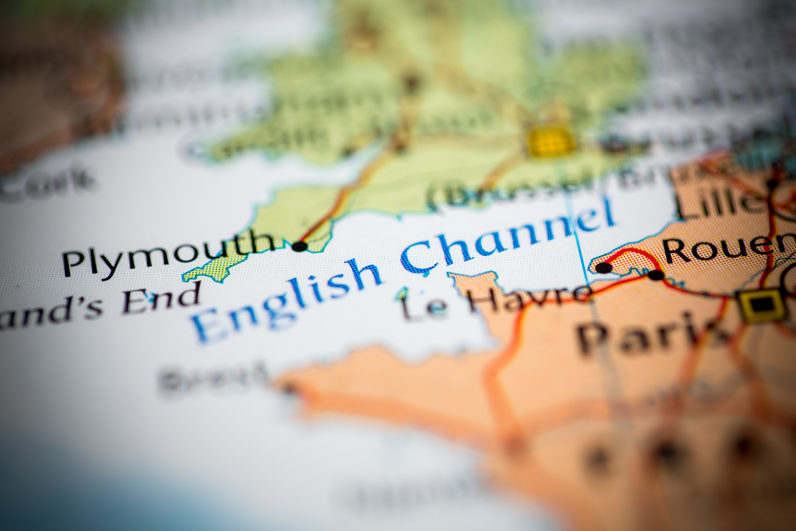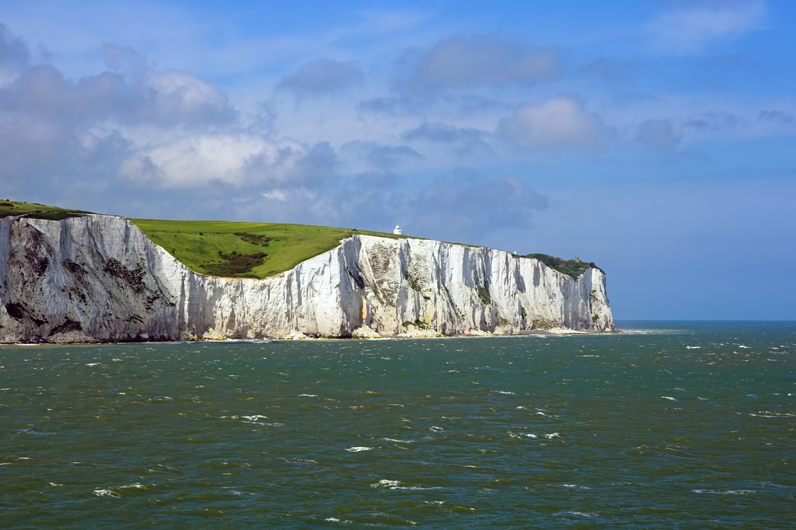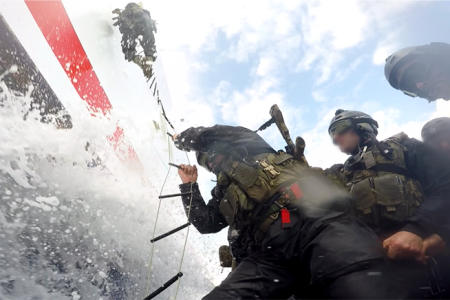Maritime security and border control on the home front
Tim Compston, Features Editor at Security News Desk, navigates the concerns being raised over the assets available to deal with people smuggling and other maritime-related border control and security issues – including terrorism – closer to home in the wake of recent incidents.
Following an unprecedented wave of terrorist attacks across Europe, greater attention is invariably being paid to how security can be ramped up at passenger ports and, crucially, on ferries plying the waterways around our coasts. A visible consequence of this has been a series of high profile exercises conducted by Special Forces, and other security assets, seeking to both provide public reassurance and to hone their skills for a potential incident.
Dublin ferry deployment
One such maritime exercise, run by the Irish Defence Forces at the start of May, was billed as the most complex the Irish had ever undertaken. The joint operation, led by the Army Ranger Wing (ARW) – the Irish Special Forces and supported by the Air Corps and Naval Service, saw assault team elements deployed by sea and air to a passenger ferry – the Stena Superfast – as it sailed towards Dublin Port. Those engaged in the training were presented with a realistic, and testing, scenario involving a vessel controlled by heavily-armed terrorists alongside a complex IED (Improvised Explosive Device) threat. Commenting on the exercise the Deputy Chief of Staff (Operations), Major General Kieran Brennan, emphasised the importance of having a flexible conventional military that is capable of ‘hedging against the complexities of the current security environment’.

Sea marshals
Another drill, this time on a Brittany Ferries vessel making its way from Portsmouth to Caen earlier this month, may be an indication of things to come on the maritime security front. In this case three armed French ‘sea marshals’ from the marine police were brought to the ship by helicopter and then travelled on with the passengers to France as a high visibility security presence. As to the implications of this for Britain, currently there is no agreement for officers to patrol vessels in UK waters, however discussions are ongoing between the French and British Governments about how best to proceed.
Commenting on the significance of the French moves, Professor Anthony Glees, Director of the Centre for Security and Intelligence Studies at the University of Buckingham, believes that the deployment of armed ‘sea marshals’ is long overdue: “I think it is a very realistic idea and it should have been done before. We know that terrorists have tried to hijack ships as well as aeroplanes in the past. Terrorists read history books like everyone else.” To support his point Glees cites the 1985 attack on an Italian cruise liner, the Achille Lauro: “Good security is about knowing where potential targets are going to be and then taking all reasonable measures to make it as hard as possible for anybody to mount a terror attack. We are all going to have to get used to that in this country.”
People smuggling
Addressing the subject of people smuggling which has also been in the headlines, the reality is that this isn’t simply an activity focused on ports like Calais or something that is happening in the Mediterranean. In June, the UK Border Force cutter HMC Seeker rescued three individuals – believed to be Iranian nationals – from a small boat off the coast near Hastings in South Sussex. Two weeks prior to that 18 Albanians were rescued from a dingy off the Kent coast. These incidents are likely to be the tip of iceberg, with residents along the south coast reporting other suspicious night-time activity and abandoned boats. Back in April the National Crime Agency (NCA) was already warning that criminal gangs, engaged in migrant smuggling, were targeting quieter ports after efforts to tighten security elsewhere and using rigid-hulled inflatable boats to access shallow beaches.
UK Border Force concerns
When it comes to maritime security around Britain’s coasts, from an immigration and border perspective, it is the UK Border Force, formed in 2012, which takes the lead in its capacity as the law enforcement command of the Home Office. With pressure on all areas of Government to cut costs to help balance the books, the UK Border Force has certainly not escaped from the austerity drive.
One money-saving decision that initially slipped under the radar but was more widely reported when a series of people smuggling incidents came to light was the move in January, by then Home Secretary Theresa May, to stop a £4 million aerial surveillance contract with Cobham – the aviation services provider – which had been in place for more than 20 years. Many commentators – including Frank Hurst, a former head of maritime operations at HM Customs and Excise, who was quoted in the Telegraph newspaper – were quick to criticise the move. Hurst said that the aerial surveillance had been extremely helpfully in spotting vessels: “You can cover a huge amount of ground. It [the decision] seems short-sighted because we built-up a lot of expertise over the years,” said Hurst.

New powers
Having said this, there appears to be a recognition by the UK Government now that more needs to be done to tackle illegal immigration via the maritime route. A case in point is the fact that at the end of May the Home Office announced new powers as part of a wide-ranging Immigration Act. The powers are designed to combat three immigration offences in the territorial waters of the UK, specifically: assisting unlawful immigration; assisting an asylum seeker to arrive in the UK and assisting entry to the UK in breach of a deportation or exclusion order.
More patrol boats
Additional patrol vessels are in the works for the UK Border Force. A statement also issued in May it was suggested that the first batch of boats would be in place ‘in the coming months’, with all of the vessels operational by the end of next year, to help tackle the smuggling of weapons, drugs and migrants into the UK. Drilling down to the type of boats planned, rather than more cutters like those currently in service, it appears that Border Force is instead to invest in a new fleet of rigid hull inflatable boats (RHIBS) as part of its future maritime strategy.
Whilst Government pronouncements on the subject may sound encouraging, and any new assets are welcome, many feel that the resources which the UK Border Agency has at its disposal are a far cry from that available to other countries. The Home Affairs Committee year-long inquiry into the ‘Migration Crisis’ released this month (August) underlines the capability gap saying that although the ‘Border Force has been given a key role in implementing strengthened coastal security measures it is clear that it is experiencing problems gaining access to a sufficient number of patrol boats.’
The Home Affairs Committee certainly doesn’t pull its punches, saying that the ‘number of Border Force vessels in operation is worryingly low.’ A table in the committee’s report brings this capability deficit into sharp relief with the three vessels attributed to the Border Force dwarfed by the 600 available to Italy’s Guardia di Finanza which has to patrol a much shorter coastline: 7,723 miles versus 4,722 miles. When I asked a Home Office Spokesperson about these numbers their response was that the UK figure only includes the number of cutters currently deployed in UK territorial waters and takes no account of the additional military and law enforcement vessels available.
Chief inspector
Regarding the way forward, amongst the many recommendations that came out of the Independent Chief Inspector of Borders and Immigration report – ‘An inspection of General Aviation and General Maritime (February – July 2015)’- published at the start of the year was the need to ‘ensure that sufficient priority is given by Border Force to improving knowledge and understanding of the threats and risks surrounding General Aviation and General Maritime’. Specifically, on the maritime side it was proposed that the Home Office – which has ultimate responsibility for the UK Border Force – should ‘develop and implement a strategy to improve the flows of information about General Maritime (GM)’. In practical terms this, the Chief Inspector said, should include: ‘ways to encourage greater voluntary reporting by GM craft, working with the Royal Yacht Association (RYA) to explore solutions to the practical difficulties for pleasure craft providing advance notification of arrival into the UK.’ He also suggested ‘better engagement by Border Force with small port authorities as a key source of information about GM vessels arriving in the UK.’

Naval support?
So where does the Royal Navy fit into the maritime security equation? Certainly the Home Affairs Committee in its report on the ‘Migrant Crisis’ would like to see Royal Navy vessels being made available to Border Force to make up any shortfall. Sadly, however today’s Royal Navy is a much diminished beast compared to ten or twenty years ago and is having to contend with problems of its own like the much talked about engine issues on the Type 45 Destroyers. The reality is that outside of the Type 45 Destroyers the navy only has a small number of vessels like patrol boats, survey ships, and thirteen Type 23 frigates which could, potentially, help to plug any gap and these already have multiple commitments from operating in the Mediterranean – ironically in this case as part of EUNAVFOR Operation SOPHIA looking to seize smugglers’ vessels on the high seas – to the Gulf and monitoring Russian naval assets transiting through the English channel.
There have been some stories in the media already that the UK Border Force has been in talks with military planners regarding the type of assistance which could be offered from naval ships to offshore raiding craft manned by Royal Marines and Special Forces.
Seeking some clarity on the position I contacted the MOD where a spokesperson told me that: “There is currently no request for military support in the English Channel.” The spokesperson was unwilling at this stage to comment on speculation around any possible Navy involvement in controlling illegal immigration in the English Channel. He also stressed that “We [The Royal Navy] do not routinely engage in enforcement of the UK maritime border, or the monitoring or control of illegal immigration across the English Channel, which remains a task of the UK Border Force under the Home Office.”
Different challenges
Of course, whatever the resources that the UK Border Force and other assets that the Government can call upon, it has to be stressed that the English Channel and the wider UK coastal waters are a very different proposition from the Mediterranean where there has been a large amount of people smuggling activity by boat to date. Certainly, according to the experts, there are a series of practical differences to factor in: from the distances involved, to weather, the numbers, the high density of shipping traffic, different contiguous nations, the fact that Schengen and non-Schengen countries are involved, and that unlike somewhere like Libya, the criminal gangs don’t have a ‘safe country’ to operate out of. On the terrorism front, it will certainly be interesting to see, moving forward, if the UK Government follows the French example and starts to deploy armed personnel on cross-channel ferries or if the idea hits troubled waters.
[su_button url=”https://www.securitynewsdesk.com/newspaper/” target=”blank” style=”flat” background=”#df2027″ color=”#ffffff” size=”10″ radius=”0″ icon=”icon: arrow-circle-right”]For more stories like this read the Security News Desk Newspaper[/su_button]
Header image credit: Irish Defence Forces













